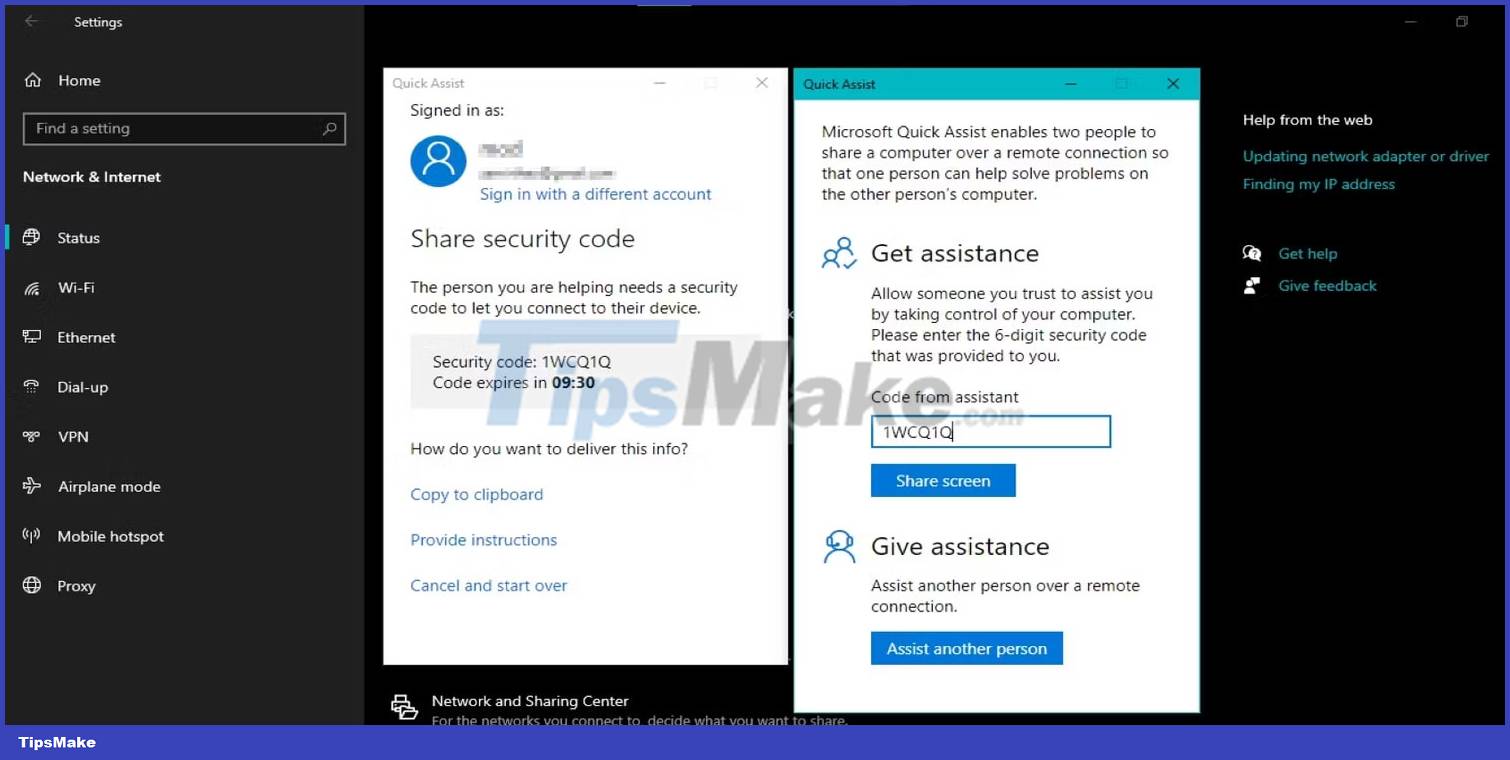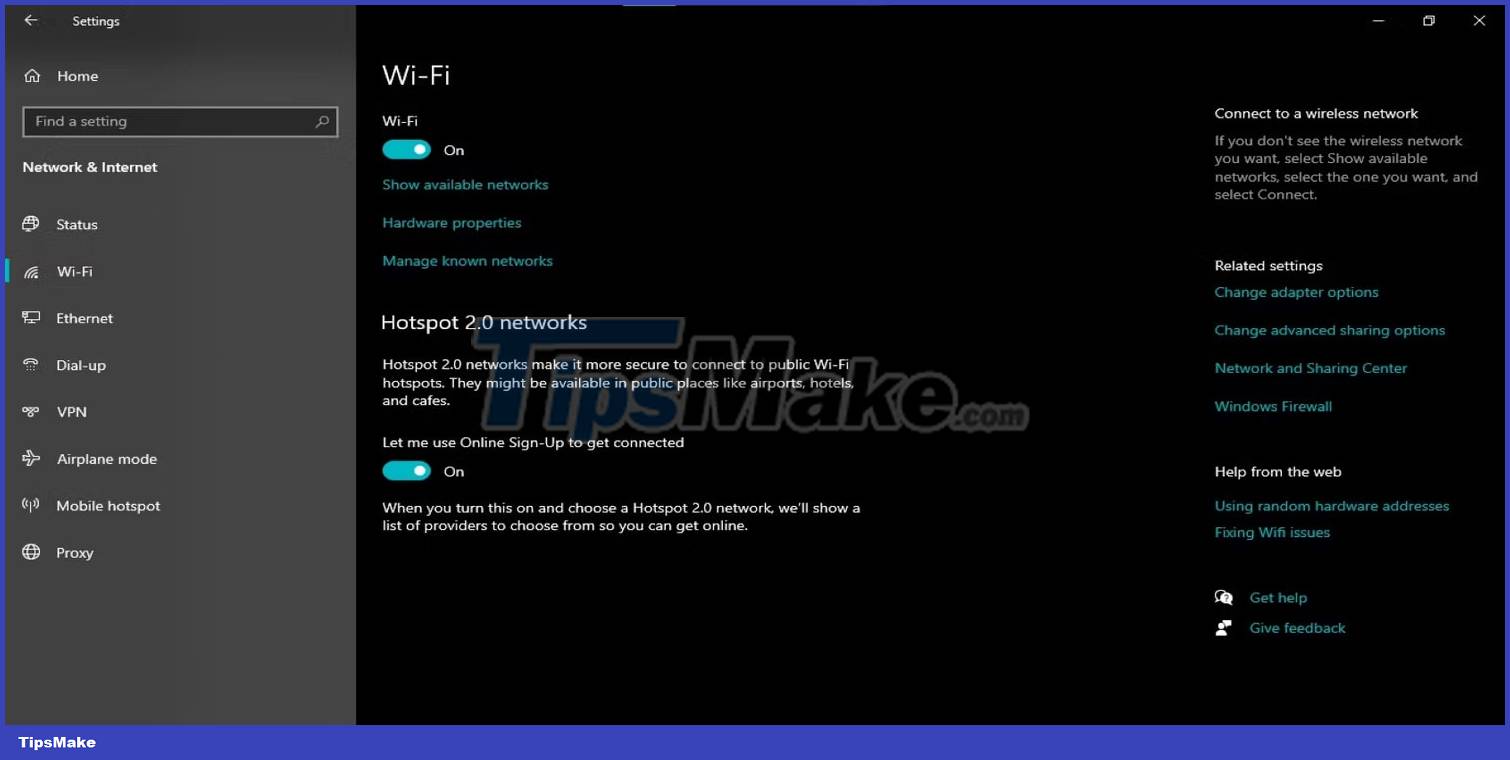4 handy networking tools built into Windows 10 PCs and their functions
However, setting up and maintaining a network can be difficult, especially if you're not tech-savvy.
Fortunately, Windows 10 offers some built-in networking features that can make things easier. In this article, we'll explore 4 of the best networking features for Windows 10 PCs to help you stay connected and productive.
Best networking features for Windows 10 PCs
Windows 10 has many networking features for personal and professional use. Some of the best tools include:
1. Quick Assist

Quick Assist is a built-in remote assistance tool on Windows 10 PCs that allows one user to control another user's computer and provide remote assistance. It can be useful in many situations, such as providing technical support to a friend or helping a colleague solve a problem.
To use Quick Assist in Windows 10, launch the program from the Start menu. You can download it from the Microsoft Store if you don't have it on your computer. If you're using Windows 11, see how to start the Quick Assist tool on Windows 11.
When the program is opened, you must grant permission to the connection and the support provider. Once the connection is initiated, the facilitator can view your screen and operate your mouse and keyboard. This allows them to solve any problems or show how to perform tasks. It's important to note that you have full control of your PC during the process and can end the session at any time.
Quick Assist allows you to remotely access another computer over a secure, encrypted connection. As a result, personal information and data are protected. Moreover, it is accessible on all Windows 10 and even Windows 11 computers.
2. Network Reset

The Network Reset feature in Windows 10 is a troubleshooting tool that helps solve network connectivity problems by resetting network settings to their default state. It can be helpful if you are experiencing slow Internet speeds or cannot connect to the network.
To use the Network Reset feature in Windows 10, open the Start menu and go to Settings > Network & Internet . Select Status from the menu on the left. Next, scroll down to the Network Reset section and click Reset now .
Windows will confirm that you want to reset the network settings and do so. It may take a few minutes. Once the reset is complete, Windows will restart the network components, you may need to reconnect to the WiFi network and other network devices.
It should be noted that resetting network settings will delete all previously configured network settings and connections, including WiFi networks and VPN connections. Therefore, you will need to reconfigure these connections after performing a network reset.
In most cases, Network Reset is a quick and effective way to resolve network connectivity issues. For example, this is one of the fastest ways to fix Network Discovery when it stops working. This feature can save you time and effort compared to manual troubleshooting and is a great first step if you have network issues.
3. Virtual Private Network (VPN)

A virtual private network (VPN) is a secure connection that allows you to access a private network (such as an office network) over the Internet. A VPN ensures that your Internet connection is encrypted and secure, even when accessing the Internet from a public location.
VPNs mask your IP address, making it harder for others to track your online activities. It helps protect your sensitive information, such as passwords and credit card numbers, from prying eyes. In addition, a VPN encrypts all the data you send and receive over the Internet, protecting it from hackers who want to intercept and steal your information.
If you're setting up a VPN on your Windows 10 PC, open Settings from the Start menu or press Win + I . Click Network & Internet and select VPN from the list of options on the left side of the menu. From the VPN menu, click Add a VPN connection .
Fill in the information needed for your VPN connection, including the server name or address, VPN type, username, and password (if needed). Then click Save to add the VPN connection.
To connect to the VPN, go back to the VPN settings page and select the VPN connection you just created. Then click Connect. You should now be connected to the VPN and be able to access the private network over the Internet.
4. Wireless Network Management

Windows 10 has a built-in Wireless Network Management feature that makes it easy to manage and connect to a wireless network. The feature is located in Settings > Network & Internet > Wi-Fi and lists all available wireless networks.
You can connect to a network by clicking on its name. The secure network may require a password or a custom login site. If your desired network is not listed or is missing, click Find a network to search more.
Once connected, you can manage your connection by clicking on the network name in the list of available networks. Here you can view information about the network, such as the security type, signal strength, and the IP address assigned to the device.
Windows 10 PCs can automatically connect to a network if the network is within range. To turn off this behavior for a specific network, click Forget and confirm your choice.
Finally, the Wireless Network Management feature in Windows 10 makes managing your wireless connections easy.
Windows 10 has some powerful networking features that can help you manage and optimize your network connections. Without a doubt, the tools mentioned above will help meet your productivity needs whether you are a seasoned network administrator or a beginner.
You should read it
- How to view Network Adapter details in Windows 10
- Please download Wifi analyzer application - Wifi Tool, for 30 USD, free of charge
- Convenient and fast network tools for iPhone and Android
- ThisIsWin11 tool customizes Windows 11 to run better
- 5 best tools to detect 'errors' on the network you are using
- Instructions for enabling or disabling Snipping Tool in Windows 10
- Learn about Microsoft Network Monitor tool - part 1
- Cannot find Snipping Tool on Windows 10? This is how to fix it
May be interested
- Learn about the management and monitoring functions of Resource Monitor tool
 in the following article, we will show you some of the features and usage of the handy resource monitor tool from microsoft, which is used to manage and monitor the operation of the network system. storage capacity and system performance ...
in the following article, we will show you some of the features and usage of the handy resource monitor tool from microsoft, which is used to manage and monitor the operation of the network system. storage capacity and system performance ... - Don't miss out on useful tools available on Windows 10!
 the tools built into windows 10 are often overlooked, with little attention paid to. but if you know and can take advantage of it, the operations when working on your computer will be faster, as well as bring many other benefits.
the tools built into windows 10 are often overlooked, with little attention paid to. but if you know and can take advantage of it, the operations when working on your computer will be faster, as well as bring many other benefits. - Windows 8 will focus on social networking
 windows 8 focuses more on the user experience, longer battery life and social networking capabilities.
windows 8 focuses more on the user experience, longer battery life and social networking capabilities. - The basic difference between Windows 7 HomeGroup and Windows XP Networking
 it can be said that windows 7 has brought a big change in file and data sharing - which has existed for a long time in previous windows versions. and with windows 7, we can mention the concept of homegroup ...
it can be said that windows 7 has brought a big change in file and data sharing - which has existed for a long time in previous windows versions. and with windows 7, we can mention the concept of homegroup ... - Math functions are available in Shell
 most parts of the tutorial are mostly built on bourne shell, but this page lists all the built math functions available in the korn shell.
most parts of the tutorial are mostly built on bourne shell, but this page lists all the built math functions available in the korn shell. - Lighter alternatives to built-in Windows apps
 windows' built-in apps often feel like they were built to do just one task. they get the job done, but not as well as expected.
windows' built-in apps often feel like they were built to do just one task. they get the job done, but not as well as expected. - Instructions for drawing graph functions online
 no need for graphing software, geometric drawing tools on your computer, you can still create charts quickly and beautifully with online tools. the network administrator will introduce you to a famous online function graphing website that many users currently use is fooplot.
no need for graphing software, geometric drawing tools on your computer, you can still create charts quickly and beautifully with online tools. the network administrator will introduce you to a famous online function graphing website that many users currently use is fooplot. - How to use Windows Tweaker 5 to customize Windows
 windows tweaker 5 is a windows system tweaking tool, like windows 7, windows 10, that allows you to customize your personal interface, eliminating unnecessary functions on your system.
windows tweaker 5 is a windows system tweaking tool, like windows 7, windows 10, that allows you to customize your personal interface, eliminating unnecessary functions on your system. - Python functions are user defined
 besides the built-in python functions, you can also define python functions yourself, these functions are called user-defined functions (python). what are the benefits of using these self-defined functions, the best way to define functions in python, we'll learn in this python lesson.
besides the built-in python functions, you can also define python functions yourself, these functions are called user-defined functions (python). what are the benefits of using these self-defined functions, the best way to define functions in python, we'll learn in this python lesson. - Free network tools for Admin
 in this article we will show you 7 free networking tools, which are really useful tools for network administrators.
in this article we will show you 7 free networking tools, which are really useful tools for network administrators.










 5 ways to fix lost UEFI Firmware Settings menu error in Windows 10
5 ways to fix lost UEFI Firmware Settings menu error in Windows 10 How to disable Modern Standby on Windows 10/11
How to disable Modern Standby on Windows 10/11 What you need to know about WebView2 as a Windows 10 user
What you need to know about WebView2 as a Windows 10 user How to change Windows user account password using Command Prompt
How to change Windows user account password using Command Prompt TOP 5 ISO file editing software on Windows 10/11
TOP 5 ISO file editing software on Windows 10/11 Instructions for installing Dynamic Island on Windows
Instructions for installing Dynamic Island on Windows